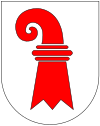Flag and coat of arms of the canton of Basel-Stadt and the city of Basel
The coat of arms of the city of Basel and the half-canton of Basel-Stadt is a black crook pointing to the left ( heraldic : right), called the Baselstab , on a white (heraldic: silver) field. Three cross bars interrupt this rod, which widens towards the bottom and ends in three points. The symbol of the Basel staff is the curved pastoral staff of the bishops. Shield holders are lions, wild men , angels and, since the 15th century, basilisks - dragons with a cock's head and snake tail.
The oldest known representation of a bishop's staff can be found on coins that were minted in the 11th century; the current form of the staff has been used since the 13th century. The stand colors are white and black.
Blazon
The official blazon of the coat of arms of the canton of Basel-Stadt reads:
- A black Basel staff in silver.
history
Origins
The coat of arms appeared for the first time between 1072 and 1133, at that time still in the form of a wooden stick, which ended in gold at the top. In the 12th century, the staff appeared in its current form, the symbol was quickly assigned to the diocese of Basel and the city as a state entity, which was the center of the diocese at that time.
The first mention of the coat of arms of the bishops of Basel comes from 1384, at that time with two coats of arms on the left and right of the bishop's staff. The bishop's staff can also be seen in seals from this period.
Differences to the coat of arms of the canton of Basel-Landschaft

In the early 14th century, in contrast to the coat of arms of the Principality of Basel, which showed the bishop's staff in red on a silver background, the coat of arms of the city of Basel was created. In 1385, the coat of arms of today's half-canton Basel-Stadt officially became the coat of arms of the city of Basel. After the Reformation, the city and the diocese finally separated. The areas ruled by the city were reformed. After the prince-bishopric fell in 1792, the episcopal coat of arms was no longer used. When the two Basel cantons were separated in 1832, the coat of arms of the prince-bishopric along with the coat of arms of the city of Liestal served as a model for the coat of arms of the canton of Basel-Landschaft, with the bishop's staff facing to the right and additional round bulges on the upper part (so-called sieve dots ). .
The different sign holders
The shield holders also date from the early 14th century, at first angels were popular as figures, then, at the end of the 15th century, they were first replaced by lions and then by basilisks. Only in the 19th century did the basilisk disappear again as a shield holder. Later the Wilde Mann was partly used as a shield holder.
literature
- Louis Mühlemann: coat of arms and flags of Switzerland. 3. Edition. Bühler-Verlag, Lengnau 1991, ISBN 3-9520071-1-0 .
Individual evidence
- ^ Louis Mühlemann: Coats of arms and flags of Switzerland. Bühler-Verlag, Lengnau, p. 86.
- ^ Canton of Basel-Stadt in the Official Wappenlexikon



